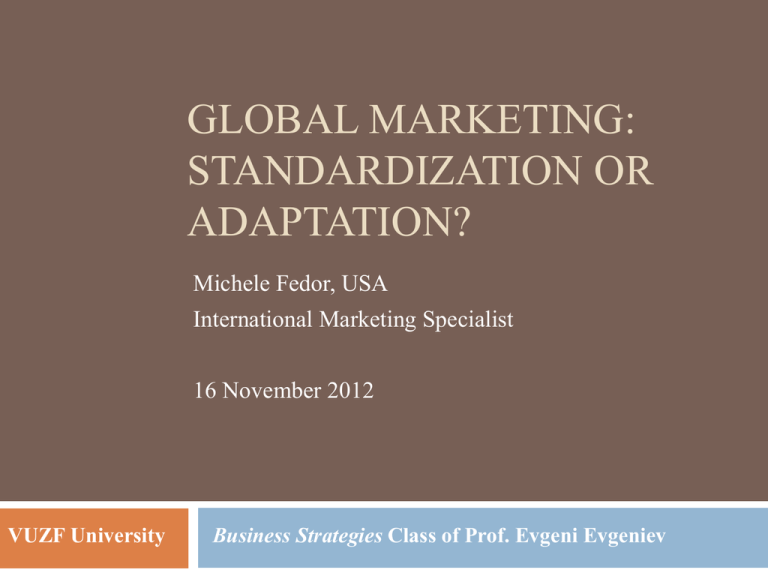Global Marketing Standardization or Adaptation?
advertisement

GLOBAL MARKETING: STANDARDIZATION OR ADAPTATION? Michele Fedor, USA International Marketing Specialist 16 November 2012 VUZF University Business Strategies Class of Prof. Evgeni Evgeniev Globalization : the act or process of globalizing : the state of being globalized; especially: the development of an increasingly integrated global economy marked especially by free trade, free flow of capital, and the tapping of cheaper foreign labor markets Globalization The trend toward a single, integrated and interdependent world Economists: emergence of global markets Sociologists: convergence of lifestyles and social values Political scientists: reduction of national sovereignty CEO/Marketing Manager? Global Business Framework Global Business EPRG Framework (Dr. Howard V. Perlmutter, Wharton) "The more one penetrates into the living reality of an international firm, the more one finds it necessary to give serious weight to the way executives think about doing business around the world.“ Organizational world views shaped by how company was formed, CEO's leadership style, administrative processes, myths and traditions These orientations determine the way strategic decisions are made and relationship between headquarters and affiliates Global Business EPRG Ethnocentric (Home Country orientation) Domestic strategies are superior, applied to foreign markets Polycentric (Host Country Orientation) Decentralized management, affiliates manage their market Geocentric (World Orientation) Integration of worldwide marketing with no bias towards home or host country Regiocentric (Regional Orientation) Region viewed as a single market EPRG Characteristics Ethnocentric Polycentric Regiocentric Geocentric Source: Multinational Organization Development, 1979, Perlmutter, H.D. Global Business/EPRG Does not exist in the purist form Only geocentric organization decides on marketing adaption or standardization? Ethnocentric with surplus product? Regiocentric uses same ads? Polycentric insists on branding standards? Global Marketing Strategy Definitions Global Marketing Strategy Marketing Mix 4 P’s Product/Service Price Place/Distribution Promotion Global Marketing Strategy The Oxford University Press defines global marketing as “on a worldwide scale reconciling or taking commercial advantage of global operational differences, similarities and opportunities in order to meet global objectives.” Steps before entering a market Assessment of the economic, political, legal & cultural environment Selection of appropriate markets Market entry strategy Marketing Mix Global Marketing Strategy Standardization or Adaptation? Global Village Globalization implies we are becoming more alike, one “global village”… Global Village Global Village Bulgaria and Macedonia are the same? British English and American English? Women’s role in car buying? Bathing suits in different countries? Global Village Global Village Globalization Does not imply homogenized markets Does imply that we are interconnected Standardization or Adaption? Standardization or Adaption? Standardization Assumes homogenous markets and in response offers standardized products and services using a standardized marketing mix Adaption Takes into account the inherent diversity in the global marketplace and adapts the marketing mix to fit the local culture, preferences, laws and rules, infrastructure and competition Standardization Transfer of company’s best, proven ideas Learning curve Economies of scale Production, Marketing, R&D/development Simplification Greater control Consistency Easier to maintain uniform brand identity Standardization Millward Brown study found that just over one in 10 successful ads did equally well in another country truly cost efficient cross-border campaigns? Marketing Science Institute study showed distribution and price sensitivity across European countries Commodity product More mass communication, more price sensitive Increased distribution of high quality product effective in less economically developed areas Standardization Blunders Workers in an African port saw the “Fragile” symbol and presumed it was broken glass, threw it all in the sea (Neil Payne, 2008, proz.com) Standardization Blunders Golf ball manufacturer packaged golf balls in packs of four; “four” in Japanese sounds like death and items in fours are unpopular www.kwintessential.co.uk Standardization Blunders Sportswear manufacturer Umbro named a running shoe Zyklon; the same name as the lethal gas used in extermination camps in WWII Yunker, 2002 Standardization Blunders The American beer company Coors used the slogan ‘Turn It Loose’ in its marketing campaign Translated into Spanish, it read "Suffer From Diarrhoea." Yunker, 2002 Standardization Blunders Dutch Company Neerlandia exports milk powder in tin boxes to African countries; switched to alu-packs made of aluminum foil Local customs officials became suspicious, believing they contained illegal drugs Customers stopped buying the product; they had been using the tins as vessels for boiling water and preparing food, and even as building material Neerlandia reverted back to the reusable tin box packaging http://www.deseretnews.com/article/705374644/Cultural-tastes-affect-international-foodpackaging.html?pg=all Adaption Specialization Directly address consumer preferences Allows for consideration of cultural, legal, social, economic issues Use local marketing knowledge More targeted advertising Strategize against competition Aware of logistical opportunities Adaption Blunders In its 2013 catalog, Ikea, in a bid to “localize” for the Saudi Arabian market, removed women from its catalog Ended up being called “sexist” and lost face Standardization or Adaption? Standardization or Adaption? Under what circumstance can a company in Country X sell its product in Country Y without changing product, price, place, or promotion and earn a suitable return? Reality It is rare to find a completely standardized marketing mix The theory of standardization works on a strategic level, often not suited for the detail required on an operational and tactical level Standardization and adaption should be evaluated as two ends of a spectrum Which marketing mix elements should be standardized or adapted and to what extend Reality Perspective of Contingency Instead of total standardization or total adaptation, this perspective seeks a balance The degree of standardization is determined by the external environment and internal organizational factors “Companies that operate in foreign markets should have eclectic abilities to seek integration, sensitivity and learning on the global scale at the same time, and standardization and adaption should not be evaluated as approaches that cannot be coordinated.” Source: Jain, 1989; Cavusgil et al., 1993 Glocalization Objective of Glocalization Find the optimal combination of integration and rationalization of operations in a global market Find synergies, adapt for the rest Think Global, Act Local Most important is to decide which strategic elements should or must be standardized or adapted and to what extent, under what conditions and when Global Marketing Strategy Framework Standardized Communication Strategy Localized Communication Strategy Standardized Product/Service Global Strategy Glocal Strategy Localized Product/Service Glocal Strategy Local Strategy Glocalization McDonald’s offers beer in Germany, wine in France, mutton pies in Australia, Veggie McNuggets in India, Teriyaki Burger in Japan, McLaks in Norway Nokia offers an anti-dust keypad for its phones that was made specifically for India Proctor & Gamble offers Ariel detergent in small sachets that are affordable in the Nigerian market PepsiCo’s most popular Lays Chips are: cheese onion in the UK, lemon in Thailand, Paprika in Germany, seafood in China Glocalization - Kraft Kraft Oreos Brand turned 100, with $2 billion in sales in 2011 (25% increase) Emerging markets account for half of the brand’s sales Maintains the fun, family oriented “twist, lick, dunk” communications strategy Product adapted to the market http://youtu.be/QHIAHJ6n w0k Glocalization - Kraft Oreo was underperforming so badly in China, Kraft was on the verge of pulling it Reformulated cookie to be less sweet and added flavors/wafer options and used Yao Ming in ads Today, China is the second largest consumer of Oreo products after the U.S. Glocalization - Kraft In India, the cookie was too bitter; reformulated and added flavors, tailored ads to local consumers, Oreo India website, social networking Lower pricing strategy (5 and 10 packs), and local distribution Between Jan-Sept 2011, sales grew 40% Glocalization - Kraft Glocalization - Kraft Showing breastfeeding Sugary cookie in baby’s hand Pulled off Facebook, labeled “NSFW” (not suitable for work) Censored in other media Glocalization - Mattel Mattel’s Barbie Sales rose in Japan from near zero to 2 million after Mattel allowed its affiliate to change Barbie’s features (closed mouth, rounder face, bigger eyes) Glocalization - Mattel Mattel’s Barbie Flagship store opened in China in 2009 on Barbie’s 50th birthday Ambitious marketing push into world’s most populous region http://youtu.be/Ys3xDC EfTkc Glocalization - Mattel Mattel’s Barbie 2 years later, the store is closed Was Mattel it the strategy? insists it is not giving up on Barbie; still sold in more than 1,000 retail outlets Standardization or Adaption? Reality is that pure standardization and pure adaption don’t really exist, and they shouldn’t Global marketing is too complex for simplistic answers Most important is to decide which strategic elements should or must be standardized or adapted and to what extent, under what conditions and when Strategy and execution are equally important Thank You! mocheafedor@yahoo.com References “Cadbury India Records 40% Growth on Aggressive Marketing Drive,” The Economic Times, January 4, 2012 “Global Marketing :Contemporary Theory, Practices and Cases,” Ilan Alon and Eugene Jaffe, 2013, McGraw Hill “Global Standardization-Courting Danger,” Journal of Consumer Marketing, Vol 3, No 2, Spring 1986 “The Glocal Strategy of Global Brands,” Dumitrescu and Vinerean, Studies in Business and Economics, 2010, vol. 5, issue 3, pages 147-155 “Guidelines for Developing International Marketing Strategies,” Wind, Douglas, Perlmutter, Journal of Marketing, vol. 37 (April 1973, pp 14-23 “Kraft Foods’s Brand New World.” Chicago Magazine, June 2011 “Pink Escalators & Spa Can’t Save Mattel’s Barbie Megastore,” Investorplace.com, March 7, 2011 Strategic Insights: to Standardize or Localize www.globalizationexecutive.com/articles/Chapter3.pdf “Standardization/Adaption of Marketing Solutions in Companies Operating in Foreign Markets: An Integrated Approach,” Engineering Economics, 2008 No 1 (56) “Standardization of International Marketing Strategy by Firms from a Developing Country,” International Marketing Review, Vol. 14 No. 2, 1997, pp. 107-123 “To Standardize or Not to Standardize: Marketing Mix Effectiveness in Europe, Marketing Science Institute, www.msi.org “Want Some Milk with Your Green Tea Oreos?,” Bloomberg Businessweek, May 7-May13, 2012






